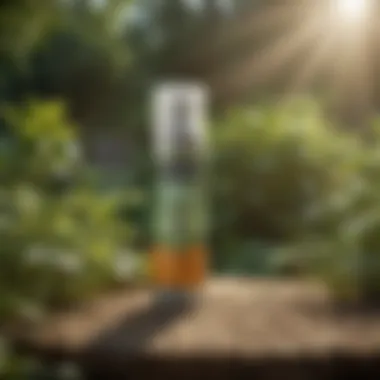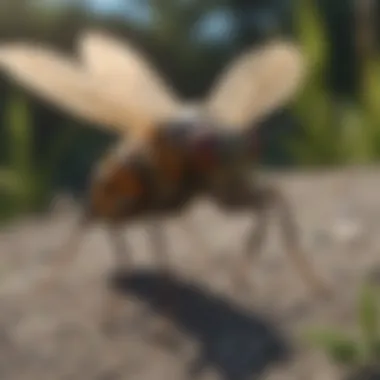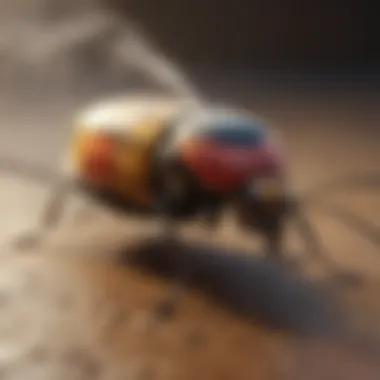Best Bug Spray for Flying Insects: Top Solutions


Intro
The presence of flying insects can significantly affect our daily lives, particularly in home settings and garden environments. Understanding these pests is crucial for developing effective strategies to manage their populations. From mosquitoes to flies, various insects demand tailored approaches for control. This guide explores optimal bug sprays specifically designed for flying insects, balancing effectiveness with safety and environmental considerations. \n\n## Understanding Pests
Definition of Pests
Pests are organisms that cause harm to human activities, including agriculture, gardens, and indoor environments. Flying pests are prevalent and may carry diseases or cause physical damage. Common examples include mosquitoes, flies, and bees. Each of these insects has specific behaviors and habitats that influence our methods of control.
Importance of Pest Identification
Accurate pest identification is essential for effective management. Misidentifying pests can lead to inappropriate treatment methods, resulting in wasted resources or unnecessary chemical applications. Understanding the life cycles, feeding habits, and breeding environments of these insects is vital for crafting a precise control plan.
"Identifying the insect type allows for targeted and efficient use of bug sprays, maximizing their effectiveness while minimizing harm to beneficial species."
Prevention Techniques
Home and Garden Preventative Measures
Preventative measures are the first line of defense against flying insects. Here are some techniques useful for homeowners:
- Seal Entry Points: Inspect windows, doors, and other openings. Use screens to prevent insects from entering.
- Remove Standing Water: This practice is crucial for mosquito control, as stagnant water serves as a breeding ground.
- Maintain Cleanliness: Regularly remove food waste and spills, which can attract pests.
- Use Natural Barriers: Consider planting specific plants such as marigolds, which repel certain insects.
Seasonal Prevention Tips
Seasonal changes can influence pest populations. Being proactive can reduce infestations:
- Spring: Prepare your garden by clearing debris where pests may breed.
- Summer: Implement regular outdoor checks for nests. Ensure that any trash is secured.
- Fall: Seal cracks and crevices around your home to prevent insects from seeking shelter indoors as temperatures drop.
- Winter: Remove any potential food sources from your yard, which might attract pests even in cold weather.
Eco-Friendly Pest Control Solutions
Overview of Sustainable Practices
Eco-friendly pest control emphasizes minimizing environmental impact while managing pests effectively. This approach is attractive for those concerned about chemical exposure. Several practices enhance sustainability:
- Integrated Pest Management: This strategy combines biological, cultural, and chemical tools. It relies on understanding pests and their interactions with the environment.
- Regular Monitoring: Keeping an eye on pest populations can help determine when intervention is necessary, leading to fewer treatments.
Natural Remedies and Their Effectiveness
Natural remedies offer an alternative to synthetic chemicals. Some effective options include:
- Essential Oils: Oils such as peppermint or tea tree can repel various flying insects. They can be diluted with water and sprayed in affected areas.
- Vinegar: A mixture of equal parts vinegar and water can deter pests. Place the mixture in an open dish during outdoor gatherings to help manage flies.
- Soap Solutions: Mild soap mixed with water can suffocate small flying insects like aphids.
Intro to Flying Insects


Flying insects are not just mere pests; they play significant roles in ecosystems and human environments. This section aims to highlight why understanding these creatures is crucial in an article focused on effective bug sprays. Knowledge about flying insects is essential for homeowners and housewives who seek to maintain a comfortable living space.
Overview of Common Flying Insects
Common flying insects include species such as mosquitoes, flies, wasps, and moths. Each type presents unique challenges and behaviors. Mosquitoes, for instance, are known for their biting tendencies and are vectors for diseases. Flies can contaminate food, while wasps tend to be aggressive when disturbed. Moths, which are often harmless in terms of human interaction, can cause damage to clothing and food stores. Knowing these characteristics helps in selecting the most appropriate bug spray.
Impact of Flying Insects on Human Activities
Flying insects can disrupt various human activities. They can transform a pleasant outdoor gathering into an uncomfortable experience. More than just a nuisance, they also pose health risks. For instance, mosquitoes can transmit illnesses like West Nile or Zika viruses. Understanding their impact is essential for effective pest control. This understanding allows one to make informed decisions when choosing bug sprays. Effective solutions can help alleviate concerns about insect-related disruptions and health risks.
"Understanding flying insects is not just about knowledge; it’s about empowerment in creating a safe environment for your family."
Understanding Bug Sprays
Understanding bug sprays is crucial in effectively managing flying insect populations. These sprays serve as primary tools for both residential and commercial pest control. With the right knowledge, users can enhance their strategies for safeguarding homes and ensuring a comfortable living environment. This section will detail how bug sprays function, the various types available, and the considerations when selecting a spray for specific needs.
How Bug Sprays Work
Bug sprays function primarily by targeting the nervous system of insects, leading to their death or incapacitation. This action occurs through a combination of penetration and ingestion. Most sprays contain active ingredients that either disrupt functionalities in the insect body or cause physical harm. Many commercial sprays have fast-acting formulas, making them effective for immediate results. However, some might leave a residual effect, which aids in the continued eradication of pests over time. Knowing how these products work helps users apply them more effectively, ensuring minimal wastage and maximum efficacy.
Types of Bug Sprays Available
When it comes to bug sprays, there are several types available on the market, each with unique characteristics and applications.
Chemical Insecticides
Chemical insecticides are formulated with synthetic compounds designed to eliminate pests rapidly. Their key characteristic is potency; they typically contain strong active ingredients such as pyrethroids or organophosphates. These insecticides are popular due to their quick action and effectiveness against a wide range of flying insects. However, the primary disadvantage lies in their potential harmful effects on non-target organisms, including humans and pets. Caution must be employed during application, and proper ventilation is essential to mitigate health risks. Many users appreciate that they can achieve rapid results when dealing with significant infestations, making chemical insecticides a common choice in pest control.
Natural Alternatives
Natural alternatives are becoming increasingly popular due to their eco-friendly properties. These sprays utilize plant-derived ingredients such as essential oils or naturally occurring substances. The main selling point is their reduced toxicity compared to traditional chemical insecticides. Many people favor natural alternatives because they pose less risk to pets and humans. However, they often have a slower effect and may require multiple applications to be fully effective. Despite these downsides, their appeal lies in offering a more sustainable approach to insect control, aligning with a growing trend towards environmentally conscious living.
DIY Solutions
DIY solutions for bug control have gained traction among home and property owners. These homemade sprays can be easily crafted using common household items such as vinegar, soap, and water. The primary characteristic of DIY solutions is customization; users can adjust the recipe according to their specific needs. Moreover, they often use less harmful ingredients, allowing for a safer environment for families and pets. However, users must be cautious as improperly formulated solutions can lead to inefficacy or unintended risks. The appeal of DIY bug sprays lies in their cost-effectiveness and flexibility in addressing specific insect issues without relying heavily on commercial products.
Selecting the Best Bug Spray
Choosing the right bug spray is a critical step in managing flying insect populations. A well-selected product not only increases efficacy but also ensures safety for inhabitants and pets of your home. The wide variety of bug sprays available makes it essential to consider several factors, thus optimizing effectiveness and reducing any adverse impacts. This section provides a framework to navigate through selection criteria, focusing on the attributes of insect species, application environments, and safety measures.
Factors to Consider
Target Insect Species


Targeting specific insect species directly affects pest control success. Different flying insects exhibit unique behaviors and vulnerabilities. For example, mosquitoes are likely to breed in standing water, making their habitat specific. Understanding these characteristics helps users choose a spray designed for particular insects. An effective product might include permethrin, which works well against common pests like mosquitoes and flies. However, it is crucial to consider potential resistance in some insect populations. Choosing a product catering to the specific flying insect can lead to better suppression and control.
Application Site
The place where a bug spray is applied plays a significant role in its effectiveness. Indoor environments, such as kitchens and living rooms, require different products compared to outdoor spaces like gardens or patios. Products designed for outdoor use typically have longer residual effects and are often formulated to withstand weather elements. Indoor sprays, on the other hand, should prioritize safety and rapid action. For instance, aerosol sprays might work well indoors, but sprays for outdoor use, often in the form of liquids or granules, could be more appropriate when dealing with infestations in lawns. Matching the application site with the right product enhances success chances and minimizes waste.
Safety for Humans and Pets
Safety is paramount when spraying any insecticide. Products must be assessed for their potential health risks to humans and pets. Many commercial sprays contain chemicals that can be harmful if inhaled or absorbed by skin, especially for children and pets. Therefore, users should look for labels that indicate low toxicity, as well as any safety precautions. Natural alternatives, like essential oil-based sprays, often carry fewer risks while still maintaining efficacy. However, it is important to ensure that even natural options are suitable for your living situation. Understanding the safety dynamics allows for informed choices that prioritize the well-being of all household members without compromising on pest control effectiveness.
Effectiveness of Popular Products
Evaluating how well certain bug sprays perform in real-world scenarios can influence decision-making significantly. Popular products such as Raid Ant and Roach Killer have high consumer ratings, primarily due to their ease of use and immediate effectiveness. Consumer reviews can provide insights into how products work across various similar infestations. Additionally, specialized sprays like Ortho Home Defense offer long-lasting protection and are often favored for their outdoor applications. Thus, knowing which products stand out based on real user experiences allows homeowners to invest resources where they will yield the best results.
Environmental Considerations
In understanding the best bug sprays for flying insects, it is crucial to address environmental considerations. The balance between effective pest control and preserving ecological integrity is vital, especially for homeowners who may also be concerned about the health of surrounding wildlife. The use of chemical insecticides can lead to various environmental consequences, which calls for a thoughtful examination of our options.
Impact of Chemical Insecticides
Chemical insecticides have long been a primary method for controlling flying insects. However, their widespread use raises several concerns regarding their environmental impact. These substances can seep into groundwater, affect non-target species, and contribute to biodiversity loss. Furthermore, the overuse of chemicals can lead to the development of resistant insect populations, prompting a cycle that demands even more potent chemicals.
It is essential for consumers to be aware that while these products may offer immediate results, the long-term effects can be detrimental.
"The ecological effects of chemical insecticides can extend far beyond the target insects. Careful consideration is necessary to understand their broader implications."
Evaluating Eco-Friendly Alternatives
As awareness of environmental issues grows, many individuals seek eco-friendly alternatives to traditional insecticides. These products often rely on natural ingredients, which can be less harmful to non-target organisms and the environment. Options such as essential oils, biological controls, and plant-based repellents are gaining traction as safer, environmentally-friendly choices.
When considering these alternatives, it is important to evaluate their effectiveness against flying insects compared to chemical options. Although they may not always deliver the same immediate results, their benefits often outweigh any initial drawbacks. Additionally, exploring solutions like integrated pest management (IPM) allows for a more sustainable approach. IPM combines multiple strategies to manage pest populations while minimizing damage to the environment and ensuring safety for humans and pets.
In summary, a conscious decision regarding bug sprays not only aids in managing flying insect populations but also contributes to a healthier ecosystem. By weighing the impact of chemical insecticides against eco-friendly alternatives, one can make informed choices that align with both pest control needs and environmental sustainability.
Application Techniques
Understanding the correct application techniques for bug sprays is essential for effective management of flying insect populations. This section emphasizes the significance of proper application methods and their role in maximizing efficacy.
Applying bug spray incorrectly can lead to suboptimal results. It can also harm the environment or pose safety risks. Thus, selecting the appropriate technique is vital. Adopting best practices ensures that the sprays reach their intended targets while minimizing exposure to non-target areas.
Best Practices for Application
- Read the Label Thoroughly: Before application, always read the label. It provides important information about the area of application, coverage, and safety precautions.
- Choose the Right Weather Conditions: Ideal conditions for spraying include dry weather with no wind. High humidity or rain can dilute the effectiveness of the spray. Wind can carry the spray away from the target area, resulting in wasted product and potential harm to other plants or creatures.
- Use the Correct Tools: Depending on the spray type, using a hand-held sprayer or backpack sprayer may be necessary. Ensure that these tools are calibrated correctly to avoid over-application or under-application.
- Apply at Correct Time: Early morning or late evening are optimal times for spraying. Insects are more active during warmer parts of the day. Spraying during their low activity periods increases the likelihood of contact.
- Target Specific Areas: Focus on areas where flying insects are commonly found. For example, spraying near doorways, windows, or where plants are infested. This targeted approach improves effectiveness and reduces unnecessary spraying.
- Observe Safety Precautions: Protect yourself by wearing gloves and a mask. This prevents exposure to chemicals present in some sprays.
Following these best practices leads to effective insect management while ensuring the safety of users and the environment.


Safety Precautions during Usage
Safety should always be a primary concern when using bug sprays. Here are essential precautions to consider:
- Personal Protective Equipment (PPE): Always wear suitable clothing, gloves, and protective eyewear. Avoid skin contact and inhalation of spray particles.
- Ensure Adequate Ventilation: When applying sprays indoors, ensure proper ventilation. Open windows and doors to allow air circulation, reducing inhalation risk.
- Store Products Safely: Keep bug sprays out of the reach of children and pets. Store them in a cool, dry place.
- Avoid Overuse: More is not always better. Using excess spray does not guarantee better results but can create health hazards and environmental risks.
- Follow Disposal Guidelines: Dispose of empty containers according to local regulations. Avoid pouring leftover products down sinks or toilets, as this can pollute water systems.
Remember: Always prioritize safety for yourself, your family, and the environment when applying bug sprays. Proper precautions can greatly reduce risks while ensuring effective pest control.
Post-Application Care
Post-application care is a crucial component of effective pest control. After applying bug sprays, taking the necessary steps ensures that the treatment is effective while maintaining safety. This section will explore the key elements of post-application care, including monitoring insect activity and handling any residual effects.
Monitoring Insect Activity
Once you have applied a bug spray, monitoring insect activity becomes essential. This involves observing the area to determine if the treatment has been effective. Here are important points to keep in mind:
- Observe the Insect Population: Check the treated areas regularly after application. Note whether the number of insects has decreased significantly. This can help you assess the effectiveness of the product used.
- Identify Species: Different insect species may respond differently to various treatments. Being aware of which insects persist can guide further actions.
- Frequency: Monitor the area for at least a few days after application. This gives a clearer picture of how well the spray is working.
In addition to monitoring for insects, it's important to check for any potential issues that can arise. For example, if you see increased insect activity, this could suggest that the spray was not effective, or that the area needs re-treating.
Handling Residual Effects
After using bug sprays, it is also essential to manage any residual effects that may arise. Residue can remain long after application, which can have implications for humans and pets. Here are some considerations:
- Read Product Instructions: Always follow manufacturer guidelines regarding safety after application. Some products may require air ventilation or waiting periods before re-entering a treated area.
- Clean Surfaces: If the residue is on surfaces, consider wiping them down. This is particularly critical in areas like kitchens or living spaces.
- Pet Safety: Ensure that pets are kept away from treated areas until it is safe. This may involve creating barriers or keeping them indoors for a specified period.
"Proper management of residual effects can significantly impact the safety and effectiveness of pest control measures."
- Personal Hygiene: After applying any product, washing your hands and changing clothing may prevent unwanted exposure.
By considering monitoring insect activity and handling residual effects, you promote a safer and more effective pest control environment. This approach not only enhances the outcome of the bug spray used but also prioritizes safety for all household members.
Closure
The conclusion of this guide serves as a vital point to synthesize the information presented about bug sprays for flying insects. This section reviews key insights disclosed throughout the text and underscores their significance in practical applications.
Using bug sprays effectively requires a clear understanding of the insects being targeted. Specific bug sprays can be tailored for certain types of flying insects, such as mosquitoes and flies. The importance of knowing your target cannot be overstated, as it directly affects the efficacy of the product used. Moreover, safety considerations for humans and pets remain paramount when selecting a bug spray. Not every option is suitable for residential areas, particularly where children and animals are present. It is essential to consider the surrounding environment in use, particularly regarding chemical residues and their potential impact on health and the ecosystem.
An effective bug spray balances potency and safety. Eco-friendly alternatives present an ethical choice, allowing homeowners to manage pests without contributing to environmental harm. However, their effectiveness may vary, meaning some might still prefer traditional methods under specific circumstances. Ultimately, awareness and education in these matters arm consumers with the tools they need to make informed decisions.
Recap of Key Insights
- Know Your Insect: Identifying the specific flying insect is crucial for selecting the appropriate bug spray. Each insect often requires different types of insecticides.
- Evaluate Safety: Always prioritize the health of family members and pets when choosing a product; some sprays may have harmful side effects.
- Consider Environmental Impact: Acknowledging the broader implications of chemical use can guide environmentally conscious homeowners toward safer alternatives.
Final Thoughts on Choosing Bug Spray
When choosing bug spray, homeowners must weigh numerous factors, including effectiveness, safety, and environmental footprint. By thoroughly analyzing each product and its intended application, one can identify the most suitable option.
In a world where pest control continues to evolve, staying aware of the latest information and innovations in bug sprays is important to manage flying insects effectively. Understanding the provided insights leads to better decision-making, ensuring that homes remain comfortable and safe from unwanted pests.



